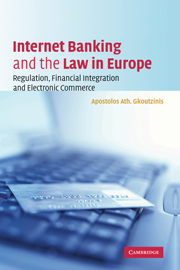Book contents
- Frontmatter
- Contents
- Tables
- Preface
- Tables of legislation
- Table of EU legislation
- Table of international conventions
- Table of cases
- Abbreviations
- Introduction
- PART I Introduction to electronic finance and Internet banking
- PART II Online banking and international market access: The causes of incomplete financial integration and what to do about them
- 3 Legal barriers and necessary regulatory reforms
- 4 The governance of the European market in cross-border electronic banking activities
- PART III EU harmonization and convergence of national laws relating to electronic banking activities
- PART IV Applicable law and allocation of regulatory responsibility in cross-border electronic banking activities
- Conclusions
- Select bibliography
- Index
3 - Legal barriers and necessary regulatory reforms
Published online by Cambridge University Press: 11 August 2009
- Frontmatter
- Contents
- Tables
- Preface
- Tables of legislation
- Table of EU legislation
- Table of international conventions
- Table of cases
- Abbreviations
- Introduction
- PART I Introduction to electronic finance and Internet banking
- PART II Online banking and international market access: The causes of incomplete financial integration and what to do about them
- 3 Legal barriers and necessary regulatory reforms
- 4 The governance of the European market in cross-border electronic banking activities
- PART III EU harmonization and convergence of national laws relating to electronic banking activities
- PART IV Applicable law and allocation of regulatory responsibility in cross-border electronic banking activities
- Conclusions
- Select bibliography
- Index
Summary
The rather poor contribution of electronic commerce to further liberalization of financial services in Europe, especially at the retail level, is neither surprising nor incidental. It is yet another instance of gaps in the legal and institutional framework of the single European market and symptomatic of the ongoing antagonism between legal and regulatory control – which is inherently national and local – and the provision of financial services across national borders.
The causes of incomplete European integration in online financial services
Although physical barriers at the border and tariffs do not obstruct the cross-border flow of capital and financial services, certain types of laws and regulations raise significant obstacles to international finance.
Legal barriers and international banking
Legal barriers to international economic integration can be express and intentional (direct or discriminatory barriers) or indirect and inadvertent (non-discriminatory or indirect barriers). Direct or discriminatory measures draw an explicit distinction between resident and non-resident financial institutions, investors or borrowers to the disadvantage of the non-residents (overt discrimination) or result in disadvantageous treatment of non-residents without stating so explicitly (covert discrimination). At one extreme, direct barriers can take the form of complete prohibition of cross-border capital flows and international banking by way of branches and subsidiaries. In practice, more common are less draconian operating restrictions such as exchange controls on movements of capital, limiting the presence of foreign firms to a single city or region or limiting their assets and market share to a fixed percentage of the total value of the local market.
- Type
- Chapter
- Information
- Internet Banking and the Law in EuropeRegulation, Financial Integration and Electronic Commerce, pp. 51 - 81Publisher: Cambridge University PressPrint publication year: 2006



